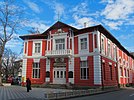
Back بزارجق Arabic پازارجیک AZB Пазарджик Bashkir Пазарджык Byelorussian Пазарджык BE-X-OLD Пазарджик Bulgarian Pàzardjik Catalan Пазарджик (Болгари) CE Pazardzhik (kapital sa rehiyon) CEB پازارجیک، بولگاریا CKB
Pazardzhik
Пазарджик | |
|---|---|
|
Clockwise from top: Panorama of Pazardzhik, Chitalishte Videlina, Regional Historical Museum, The old post office and clock tower, Church of the Dormition, Drama and Puppet Theatre Konstantin Velichkov, Art Gallery Stanislav Dospevski | |
| Coordinates: 42°12′N 24°20′E / 42.200°N 24.333°E | |
| Country | Bulgaria |
| Province (Oblast) | Pazardzhik |
| Government | |
| • Mayor | Petar Kulenski (PP-DB) |
| Area | |
| • Town | 37.382 km2 (14.433 sq mi) |
| Elevation | 205 m (673 ft) |
| Population (2022)[1] | |
| • Town | 55,220 |
| • Urban | 90,309 |
| Demonym | Pazardzhiklia |
| Time zone | UTC+2 (EET) |
| • Summer (DST) | UTC+3 (EEST) |
| Postal Code | 4400 |
| Area code | 034 |
| License plate | PA |
| Website | Official website |
Pazardzhik (Bulgarian: Пазарджик [ˈpazɐrd͡ʒik]) is a city situated along the banks of the Maritsa river, southern Bulgaria. It is the centre of Pazardzhik Province and Pazardzhik Municipality. It is located in the Upper Thracian Plain and in the Pazardzhik-Plovdiv Field, a subregion of the plains. It is west of Plovdiv, about 37 kilometres (23 mi), 112 kilometres (70 mi) southeastern of Sofia and 288 kilometres (179 mi) from Burgas. The population is 55,220, as it has been growing around from the end of the 19th century to the end of the 20th century. The city reached its highest milestone, exceeding 80,000. Due to poor economic performance in Bulgaria during the 1990s and early 2000s, emigration of Bulgarians began, which affected Pazardzhik as well.
The history of Pazardzhik can be traced back to the 7th millennium BC, with early civilisations being brought from Asia-Minor. They were agro-pastralists and settled near Maritsa, Pazardzhik and Sinitovo. A clay idol named the Pazardzhik Venus was founded in 1872. The Drougoubitai tribe settled in the early Middle Ages. Many different researches have all been disputed on the founding of Pazardzhik. One of them was that the city was founded in 1395 by nomads from Saruhan. Another one was three years later in 1398, the city was founded by the migration of Tatars from Actav to Rumelia. The third is about the establishment in 1418, where the Minnet Bey and the Tatars came from Isquilip, and the fourth thesis and the final one is the city's foundation from the resettled Crimean Tatar people. Rice cultivation intensified in the region, which made the economy of the city grow.
During the Russo-Turkish War (1806–1812), there was a brief siege under Count Nikolay Kamensky. In the mid-19th century, it was an important craft and trade centre. Many institutions were established in this period. Тhe Church of the Dormition was first founded. Vasil Levski appointed the revolutionary committee in Pazardzhik as a second centre in 1872. Following 4 years after that, Georgi Benkovski resumed the activity of the committee. During the Russo-Turkish War (1877–1878), Iosif Gurko wrestled the Ottomans out of the city and during the same period, Ovanes Sovadzhian prevented the annihilation of the city. The first reported Red Army troops entered Pazardzhik on 23 September 1944. After 9 September 1944, the city grew to an industrial centre, which in 1947 during nationalisation, began consolidation of industrial enterprises. There were demonstrations consisting of about 5,000 protesters, demanding to change to democracy.
The economy of Pazardzhik is now a slowly growing one. GDP per capita is 9,101 BGN in 2012. The average monthly salary was 635 BGN and unemployment was 5.2% in 2015. The economy today is mainly based on agriculture, which also includes animal breeding. Farms are mainly located in the fertile land of the Upper Thracian Plain. The landmarks of the city are the clock tower, Church of the Dormition, which has a wood-carved iconstasis protected by UNESCO,[2] the History Museum, the old post office, the Drama Theatre and others.
- ^ НАСЕЛЕНИЕ КЪМ 31.12.2022 Г. ПО ОБЛАСТИ, ОБЩИНИ, МЕСТОЖИВЕЕНЕ И ПОЛ
- ^ "Bulgaria's Pazardzhik between Palm Sunday and Easter". Bulgarian National Radio. Retrieved 15 January 2023.










